Westphal Research Round-Up: Six Faculty Present Latest Projects at Westphal Creates
March 14, 2023
On Friday, February 24, 2023, Drexel’s Antoinette Westphal College of Media Arts & Design held its annual showcase of faculty research, scholarship, and creative work, organized by the Westphal Research Council. Featuring five-minute presentations by faculty members from each of the College’s departments, the event was an exploratory window into the cutting-edge projects happening in the creative heart of Drexel University.
Here, you’ll find a recap of the day’s presentations, as well as resources to learn more about faculty projects and research collaboration opportunities.
Mark Stockton, Associate Teaching Professor of Visual Studies
Department of Art & Art History
Durational Drawing: Towards 100 People
In the spring of 2022, Mark Stockton opened Mark Stockton: 100 People at the Annenberg Center, with support from the Sachs Program for Arts Innovation and Penn Live Arts. The exhibition is a group of 100 hand drawn portraits, photo-referent, made with graphite on paper, and intended to be received as a single work in form and experience. Each subject connects via eye-contact to the viewer, addressing the objectifying nature of portraiture head-on. Portraits have a complex history – they have the potential to venerate, to emotionally connect, to resonate into lived experience – they are also tools of commodification, objectification, and colonialization.
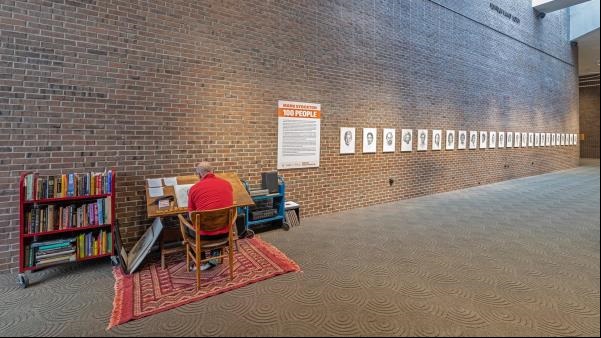
95 of the 100 drawings were completed when the exhibited opened in January 2022; Mark completed the remaining five over the course of the exhibition, during scheduled drawing hours in the Arts Lounge. Visitors from the public, or those attending performances at the Annenberg, were invited to watch Stockton’s progress as he drew. Stockton immersed himself in the life and works of the subjects of his 100 drawings, building connections while drawing by listening audiobooks or podcasts that pertained to their biographies or creative works. As part of the show, he compiled a bookshelf of reference, which could be used as a discussion point with visitors.
During his presentation at Westphal Creates, Stockton paused to acknowledge how his artistic practice has influenced his teaching. He shared examples of student work produced in his drawing classes, which used similar cross-contour techniques to produce photo-referent portraits.
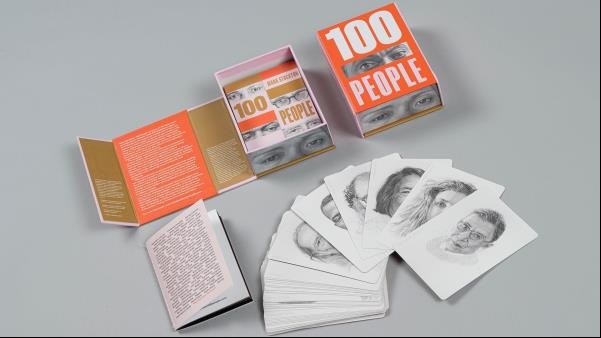
As a culminating exercise, and with the support of Drexel University’s Freddie Reisman Creative Award and a Westphal Mini-grant, Stockton produced a limited-edition publication of 100 People. Rather than a traditional book of the images, Stockton worked with graphic designer Elaine Lopez and photographer Jaime Alvarez to transform the body of work into a deck of 100 cards in a magnetically sealed box. The deck reflects the non-hierarchical display of the exhibition, leaving it up to the viewer to determine the order. He’s even had a friend conduct Tarot-inspired readings with the deck.
Learn more: mtstockton.com
June He Assitant Professor, Product Design
Department of Design
Making Diverse Voices Heard: Building Community-Based Co-Design Projects with Older Asian Communities in Philadelphia
In September of 2021, June He’s neighborhood – a small, residential community in New Jersey – experience heavy flooding during Hurricane Ida. An older neighbor, who immigrated from China and speaks little English, enlisted He’s help to navigate the situation, from reading the community booklet to filling out paperwork to apply for assistance from FEMA. It was an eye-opening experience for He, who learned about the isolation many older adults feel, especially immigrants. Compounded by the pandemic and the rise in Anti-Asian hate crimes in recent years, older Asian adults are more isolated than ever.
As an immigrant herself, He empathizes with this pain. She asked herself three questions: How might design educators create experiences that include and support older adults? How might we better understand their dreams, aspirations, and fears by creating channels for communication? How might we increase students’ awareness and understanding of inclusive design in the real world?
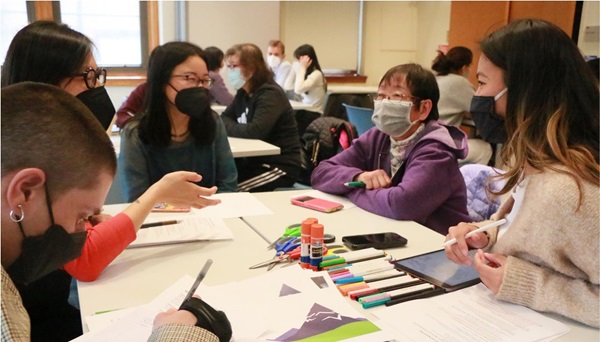
He believes community-based co-design is a great method to transcend cultural and language barriers. In the 2022 spring term, she initiated the Aging + Design course series and community outreach program. Students from various majors across Drexel University were paired with older Asian adults in the immigrant communities of Philadelphia. In the fall iteration of the course, He invited Catherine Quay, assistant clinical professor in the College of Nursing & Health Professions, to co-teach. They collaborate with two non-profit community partners, SEAMAAC and Philadelphia Senior Center, to build relationships and create age-friendly design solutions to improve the older adults’ lives.
You can read more about Aging + Design and the outcomes of the spring 2022 quarter here.
Nicholas Natalicchio, Assistant Teaching Professor of Film & Television
Department of Cinema & Television
Explorations in Documentary Filmmaking: Personal Stories that Speak to Global Issues
In addition to teaching for Drexel’s Film & Television program and running the student-staffed video production group Dragon Productions, Nick Natalicchio is an award-winning documentary filmmaker. Natalicchio directs short documentaries that speak to global and environmental issues, with emphasis on resonant human stories. He likes to joke that his style is a mix of Wes Anderson and Ken Burns: informative documentaries driven by quirky stories and characters, illustrated with whimsical animation, cinematography, and color.
Natalicchio’s debut documentary short, The Tides that Bind (2019), is the story of Clint Buffington, a collector who has found over 90 messages in bottles. He’s managed to track down many of the senders, making unlikely friends and connections along the way.
His followup, Watching the Wilds (2022), is about lookout towers used to spot and report wildfires in the Moshannon Forest District of Pennsylvania. Both The Tides That Bind and Watching the Wilds feature crews with strong ties to the Drexel community. Cinematographer Alex Djordevic is an alum of the Film & Television program, and now an adjunct instructor. Film & Television program director John Avarese serves as composer and audio engineer, and alum Max Slusky as colorist.
Natalicchio’s films are often Romantic in nature: why send a message in a bottle when we can connect so easily online? Why do lookout towers capture the imagination more than other technologies used fir fire detection, like planes or drone? Both films also speak to environmental issues. The Tides That Bind explores how Clint uses messages in bottles to draw attention to plastic pollution in our oceans. Watching the Wilds explores the causes of wildfires and how they can be prevented. Natalicchio views each film as a piece of a puzzle that allows the viewer to see a larger issue scaled down and from a different angle.
William Mangold, Assistant Professor of Interiors
Department of Architecture, Design & Urbanism
Considering Interior Experiences
William Mangold is an expert in the experience of place. In his forthcoming monograph, the Interiors Theory Primer (Routledge, 2024), Mangold will introduce readers to key theoretical areas of interior space and experience. It maps the disciplinary terrain by discussing fundamental questions of inhabitation, before extending into emerging areas of concern such as virtuality, biophilia, and social justice.
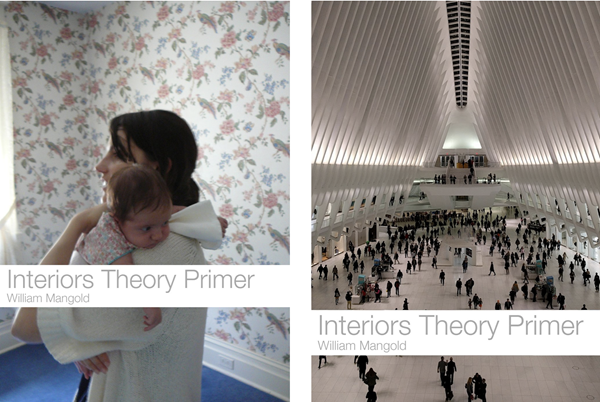
Conceived as a series of literature reviews on interrelated topics, this primer draws upon a range of historic to contemporary scholarship and design precedent examples to introduce and understand fifteen key areas of interest. Organized into three sections, the book addresses long-standing issues at the core of interiors such as place identity, atmosphere, and materiality; engages disciplinary concerns of status and media; and looks forward to consider questions of well-being and trans-human experience. Each chapter introduces a specific topic of interiors, presents a succinct review of pertinent scholarship and design precedents, and concludes with suggestions for further reading related to each topic. Intended to be accessible to students and professionals, each chapter is approximately 4000 words accompanied by 4-5 images presenting key precedents. In this way, the book provides a structure for readers to understand and engage the important contributions that comprise interiors theory.
Learn more about Mangold’s work, including Interiors Theory Primer, here.
Glen Muschio, Associate Professor
Department of Digital Media
Moses Williams & The Philadelphia Museum: Who Tells What Stories, When, Where, and to Whom?
Who decides what stories are told? How can new and emerging technologies bring invisible histories to life? These questions drive the research of Digital Media associate professor Glen Muschio. During Westphal Creates, he described his ongoing digital heritage project on the stories of Moses Williams and the Philadelphia Museum of Charles Willson Peale.
The end goal of the project is the development of a virtual storytelling space encouraging critical examination of ideas about art and science in the context of class, race and religious beliefs and practices that informed C.W. Peale’s celebrated Philadelphia Museum of Art and Science. The Peale Museum Project aims to shed light on the efforts of Moses Williams, who worked in the Museum while enslaved and, following manumission, became the silhouette portrait concessioner in the Long Room Gallery. Williams’s contributions have been largely unrecognized in historical records, but the project can bring new attention to the untold story via new technologies.
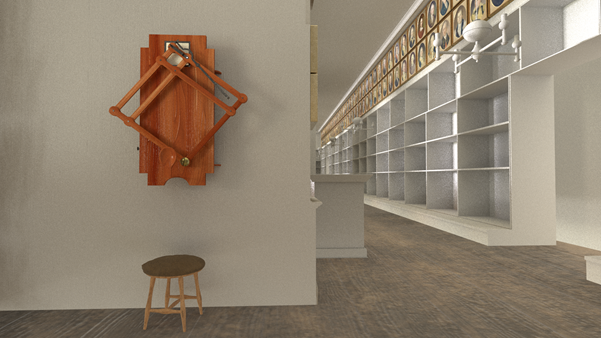
With support from Drexel University’s Summer Research Award and the STAR Scholars Program of the Pennoni Honors College, Muschio and Digital Media students have engaged in researching and modeling interior spaces and objects from the Peale Museum. STAR Scholar Nick Moy studied a replica of the physiognotrace, a contraption used to produce silhouette portraiture, at Independence National Park to create a functional digital animation of the process. Students are also engaged in producing a 3D model of Moses Williams, based on only two assumed likenesses: a painting by Rembrandt Peale and an unidentified silhouette.
Learn more about Muschio’s work in digital heritage and Philadelphia history here.
James McKinney, Assistant Professor of Music and Music Industry
Departments of Arts & Entertainment Enterprise, Performing Arts
The Flood VR: An Artistic Call To Action On Climate Change
Led by assistant professor James McKinney, The Flood VR is an immersive experience that raises awareness about the devastating effects of climate change and inspires action. Utilizing cutting-edge immersive audio and VR technology, this experience will transport viewers to a world affected by flooding and allow them to interact with it, providing crucial information and calls to action.

For the player this enveloping visual and sonic encounter travels linearly through an ominous world from a child’s flooded bedroom through townships and cityscapes where climate change has caused the world to flood. By the end of the experience, the viewer will take control and be able to virtually row the boat they are seated in toward various structures in the virtual world, which will provide relevant information on combating climate change. The aim of this immersive sensory creation is to evoke a profound emotional response from the player, just as many works of art do. By immersing the player in a compelling and thought-provoking experience, we hope to inspire reflection on their personal responsibility to care for our planet. Ultimately, the goal is to empower players to take concrete actions to address urgent environmental challenges facing our world today.
The starting point for this project is a song: The Flood, written and performed by now Drexel alumni Max Gallagher. Conceived as part of Anthems for the Anthropocene, a Drexel University-wide interdisciplinary climate change songwriting competition, The Flood won second place and inspired a powerful message. Now Max is the singer, narrator and mocap actor of The Flood VR. They’ve been recording vocals with McKinney at the Music Industry program’s Studio One, at which point the song will be mixed as immersive audio. McKinney envisions the Dolby Atmos mix applied to a future iteration of The Flood VR, in which a projected exhibit is created, like the successful traveling exhibits Bjork Digital and the Van Gogh Experience.
The Flood VR team is now developing a multi-sensory virtual reality experience using the powerful Unreal Engine VR and Oculus technology. The VR creative pipeline involves several steps and stages, which includes world & prop building, meta-human creation, motion capture performance, programing, sonic integration using meta sounds, and testing. The team has already used Unreal Engine’s Metahumans to create metahuman versions of Max and Professor McKinney.
Learn more about Anthems for the Anthropocene and hear Max’s original recording of The Flood here.
Want to learn more about Westphal’s research, scholarship, and creative work or find a collaborator? Contact us at westphalresearch@drexel.edu.